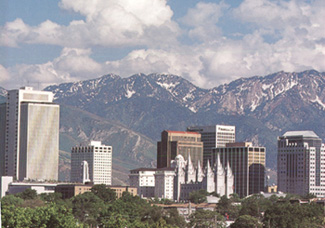Why Utah Has Low Cost Water and High Consumption
Despite being the second driest state, the population has flourished near water rich mountain water supply sources.
LeRoy W. Hooton, Jr.
March 21, 2003
|
On the supply side, Utah’s mountains are terrific snow catchers and despite being situated within the second driest state in the Union, these mountains provide copious amounts of water. Comparing ski resort data, Alta receives on average 500 inches of snow, ranking it as one of the snowiest ski resorts in the continental United States. Likewise many of the state’s mountain watersheds rank high on the amount of snow received every year. Even though many of the state’s valleys only receive 10 to 15 inches of water, the mountain ranges collect up to 30 to 60 inches of water in the form of snow. This snow melts and is stored in reservoirs and diverted into urban water distribution systems and irrigation canals and ditches. The snowmelt also recharges the state’s groundwater aquifers.
Early Utah history has contributed to the availability of water. Klotz notes that the early pioneers settled near the mouths of canyons where most of the state’s water supplies are located. “The number one reason we have low water rates is that the urban areas are located right next to where large quantities of high quality water exist,” said Klotz. “For example, Los Angeles must import most of its water supplies from sources that are 300 to 400 miles away.” The early Utah settlements have grown into major metropolitan centers fed by these same canyon streams.
When it was necessary to develop imported water supplies, the federal government helped provide the necessary reservoirs and conveyance systems. Under the 1902 Water Reclamation Act first the Bureau of Reclamation built the Strawberry Valley Project, followed by the Provo River, Ogden and Weber Projects. “These older projects provide water at a much cheaper cost than newer and more costly water development projects,” averred Klotz. The cost of [treated] Provo River Project water is $0.46 per thousand gallons, compared to the national average of $2.50 per thousand gallons. Further, state funding of water projects has contributed to the low cost of water. Future water projects will cost much more according to Klotz. The Bear River and Lake Powell pipeline to Washington County will cost from $500 ($1.53/1000 gallons) to $400 per acre-foot ($1.25/1000 gallons) respectively, and does not include treatment and distribution.
On the water consumption side, Utahns use exactly the same amount of water indoors as the rest of the country. The difference is the amount of water used to irrigate lawns and gardens. Lot sizes tend to be larger in Utah. Average lot sizes in Las Vegas are 7,400 square feet; Denver 9,200 square feet; Salt Lake City 10,000 square feet; and along the Wasatch Front 13,900 square feet. In 1995 the state’s per capita consumption was 321 gallons per day per person (gpd/p). The latest figures show a decline to 293. The state’s conservation goal is to reduce consumption by 25 percent to 241. The residential water use component amounts to 202 gpd/p; further broken down to indoor use of 70 gpd/p (35 percent) and outdoor use 132 gpd/p (65 percent).
“Besides the state’s climate and large lots planted with turf, the low cost of water definitely has an impact on water usage,” said Klotz. “Water rates are based on cost of service and cannot be arbitrarily increased, but rate structures can be designed to encourage conservation.” Many communities across the state are now implementing conservation rate structures to encourage water conservation.
Another reason Utahns may show higher water usage is the use of secondary water systems. The Division of Water Resources includes municipal secondary water consumption in its calculations, which may not be the case of other states in determining their per capita consumption.
How automatic sprinkling systems are operated appears to contribute to high water consumption. Division of Water Resources studies indicate that those who have automatic sprinkler systems and use the timer use more water than is necessary; while those who manually operate their automatic sprinkler systems, use about the right amount of water. Those who do not use an automatic system, and use a hose sprinkler use less water.
This paper sheds some light on the unique nature of Utah’s water consumption patterns and a guide to reduce wasteful water consumption. As the state of Utah continues to grow, additional water supplies will be needed to accommodate new urban areas. Water conservation, conversion of agricultural water to municipal and industrial use and new water development will be needed to meet the states water supply demand through the year 2050.
